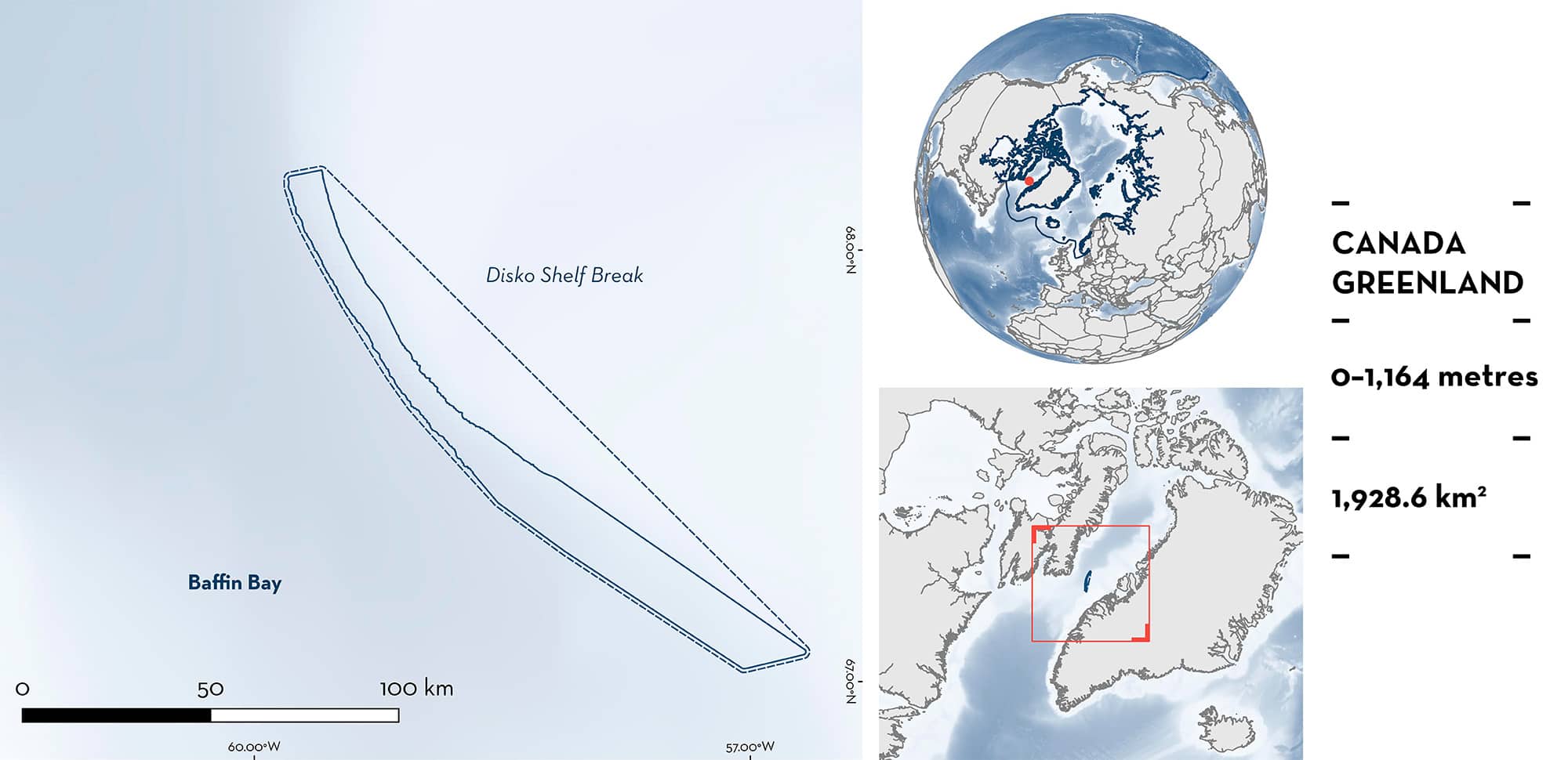ISRA FACTSHEETS
ISRA FACTSHEETS
POLAR WATERS REGION
Disko Shelf Break
Summary
Disko Shelf Break is located within the waters of Canada and Greenland. The area is situated in southern Baffin Bay, spanning the mouth of a deepwater channel that connects southern Baffin Bay to the Davis Strait. It is characterised by diverse deepwater coral communities. The oceanography of this area is complex due to a wide bathymetric range, steep gradient, and a combination of water masses. The area overlaps with the Disko Fan Conservation Area. Within the area there are: threatened species and undefined aggregations (Greenland Shark Somniosus microcephalus).
Download factsheet
Disko Shelf Break
DESCRIPTION OF HABITAT
Disko Shelf Break is located within the waters of Canada and Greenland. This area is situated in southern Baffin Bay, spanning the mouth of a deepwater channel that connects southern Baffin Bay to the Davis Strait. The area is characterised by diverse and well-established deepwater coral communities that provide structural habitat used by fishes for spawning, breeding, and nurseries (DFO 2023).
The sea ice has persistent leads through the boreal winter pack ice, which is of great significance to marine biota occupying this area in winter and known to permit the overwintering of marine mammals (DFO 2008). This area is situated where the warm (>0°C) and saline water (>34) from the north Atlantic enters Baffin Bay through eastern Davis Strait, moving northward along the west coast of Greenland. It encompasses the majority of the glacial alluvial fan known as the Disko Fan. The oceanography of this area is complex due to a wide bathymetric range, steep gradient, and a combination of water masses (Hiltz et al. 2019).
This area overlaps with the Disko Fan Conservation Area (UNEP-WCMC & IUCN 2024).
This Important Shark and Ray Area is benthopelagic and is delineated from surface waters (0 m) to 1,164 m based on the depth range of Qualifying Species in the area and the bathymetry of the area.
CRITERION A
VULNERABILITY
One Qualifying Species considered threatened with extinction according to the IUCN Red List of Threatened Species regularly occurs in the area. This is the Vulnerable Greenland Shark (Kulka et al. 2020).
CRITERION C
SUB-CRITERION C5 – UNDEFINED AGGREGATIONS
Disko Shelf Break is an important area for undefined aggregations of one shark species.
Between 2012 and 2018, 193 Greenland Sharks were tagged with acoustic transmitters in five inshore areas (Cumberland Sound, Grise Fiord, Resolute Bay, Scott Inlet, Tremblay Sound) around Baffin Island. Over the course of three consecutive years of offshore receiver deployment (November 2015 to September 2018), 155 Greenland Sharks were detected by inshore (deployed on the continental shelf between the coast and the shelf margins) and offshore (deployed along the continental slope across a depth gradient of 600–1,100 m) receivers (Edwards et al. 2022).
Offshore stations encompass a total of 24 gates. Greenland Sharks (33 females and 22 males, with a mean size of 262 ± 48 cm total length [TL]) were detected by 12 gates, of which six were within the Disko Shelf Break. More than half (n = 31) of the 55 Greenland Sharks detected offshore were repeatedly detected within Disko Shelf Break for subsequent years (from 2 to 4 years) (Edwards et al. 2022). Receivers within the area showed the highest level of reoccurrence from 19 sharks that were detected on the same receivers across years (Edwards et al. 2022). Detection events of individual sharks within the area were much longer than the estimated time for a Greenland Shark to transit past a receiver (given the tag nominal delay, detection range, and swim speed of the animal), indicating they were not only crossing the area (N Hussey pers. obs. 2024).
In 2016, 140 sharks had been tagged and 29 were detected by offshore gates, 27 within this area. In December, 12 sharks were recorded within the area, and 11 in January (Edwards et al. 2022). In 2017, 171 sharks had been tagged, of which 39 were detected by offshore receivers. All 39 sharks were detected within Disko Shelf Break in that year (n = 17 in January, n = 17 in May). Detections in this region occurred over two distinct periods: one before the ice-free period (April–June) and one after the ice-free period (November–January). In 2018, all 193 sharks had been tagged, however, two of the six gates within Disko Shelf Break had been retrieved. Still, 21 sharks were detected in the area by the four remaining gates (n = 13 sharks in June).
The detection on offshore receivers was primarily between December and June (i.e., the winter ice-covered period) with low detections from July–November (i.e., summer ice-free period) when detection was higher in coastal inshore locations which were highly productive because of ice melting (Edwards et al. 2022; Pedro et al. 2023). These multi-year trends identify a clear seasonal aggregation of Greenland Sharks within Disko Shelf Break. This area remains ice-free for a longer duration due to warm, saline water from the North Atlantic flowing into eastern Baffin Bay. This habitat hosts several prey species potentially targeted by Greenland Sharks (Hiltz et al. 2019). Further information is required to understand the function of the aggregation.
Download factsheet
SUBMIT A REQUEST
ISRA SPATIAL LAYER REQUEST
To make a request to download the ISRA Layer in either a GIS compatible Shapefile (.shp) or Google Earth compatible Keyhole Markup Language Zipped file (.kmz) please complete the following form. We will review your request and send the download details to you. We will endeavor to send you the requested files as soon as we can. However, please note that this is not an automated process, and before requests are responded to, they undergo internal review and authorization. As such, requests normally take 5–10 working days to process.
Should you have questions about the data or process, please do not hesitate to contact us.


